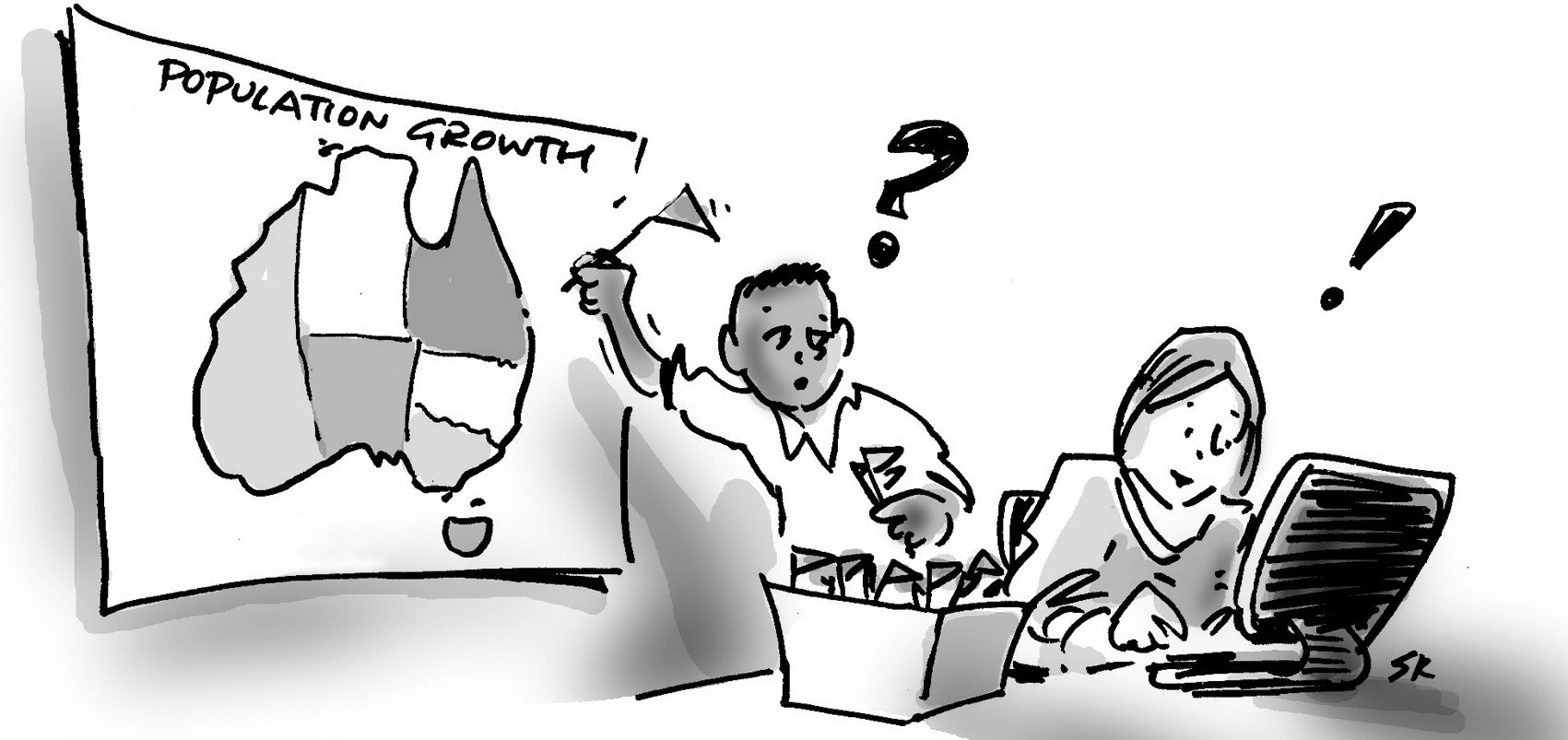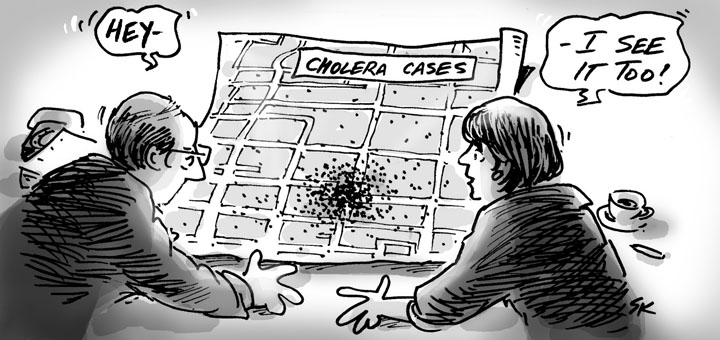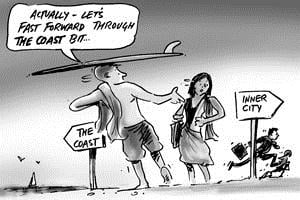BLOG
How COVID-19 will impact the future population of rural areas
How COVID-19 will impact the future population of rural areas
Accounting for around 11% of Australia’s population, rural areas cover nearly 60% of Australia’s land mass and produce the majority of its agriculture and primary industries. As such the importance of how COVID-19 may impact the population here is just as important as metropolitan and major regional cities.
So will it be a positive story for rural population growth with a potential demographic shift to younger faces at the local pub and new recruits for the local footy & netty teams? Keep reading to find out.
COVID-19 is causing major social and economic disruption which is evolving rapidly around the world. In Australia, the impacts on the size and distribution of future population growth are significant. Our forecasters are thinking about these impacts of COVID-19 on local government population forecasts and are rolling out a COVID-19 impact assessment for our local government clients.
In the first blog in the series, we introduced the framework we’re using to produce these impact assessments and answered questions like ‘Do the current forecasts account for the impacts of COVID-19?’, ‘What will the impacts of COVID-19 be?’ and ‘Will these impacts be felt the same everywhere?’.
While we know that the impact of the pandemic will be felt differently in different places, there are also similarities between how some places will be impacted. In this latest installment in the series, we’re looking at the impact of COVID-19 on Australia’s rural areas.
What is a rural area?
Despite Australia’s rural areas being extremely diverse physically, they do share some common population characteristics. From the daintree and cattle stations in the North, to the temperate old growth forests and orchards in Tasmania, similarities can be found in population size, urban form, demographics, economies and education & lifestyle opportunities. These prevalent characteristics helped us to define what a rural area is for the purpose of the COVID-19 impact assessment.
A local government area was considered rural if its total population was less than 50,000 residents, who tended to be widely dispersed inland from the coast, in the form of small townships and settlements with very low population densities. Population growth is slow and in many cases towns are shrinking as younger residents migrate to major regional and capital cities.
Generally, this is a result of young adults seeking employment and education opportunities in metropolitan and larger regional cities. Rates of growth and migration flows can vary between rural areas, with some reliant on backpackers and temporary visa holders for seasonal farm work and some home to regional university campuses. Despite generally losing young adults, rural areas tend to attract mature families and empty nesters due to lifestyle opportunities, access to the environment, affordable rural living on large allotments and economic opportunities in the form of tourism, wineries and small to large scale farming, just to name a few.
These characteristics can be attributed to 234 Local Government Areas where over 2,200,000 people reside. Rural areas who subscribe to our population forecasts are listed in the table below. Click the link in the table to view the population forecast and COVID-19 impact assessment for that LGA.
| Local Government Area (LGA) | State | 2019 ERP (rounded) |
|---|---|---|
| Bathurst Regional Council (A) | New South Wales | 43,620 |
| Berrigan (A) | New South Wales | 8,750 |
| Campaspe (S) | Victoria | 37,620 |
| Goulburn Mulwaree (A) | New South Wales | 31,130 |
| Griffith (C) | New South Wales | 27,030 |
| Hilltops (A) | New South Wales | 18,700 |
| Kyogle (A) | New South Wales | 8,800 |
| Murray Bridge (RC) | South Australia | 22,500 |
| Snowy Monaro Regional (A) | New South Wales | 20,800 |
| Upper Lachlan Shire (A) | New South Wales | 8,060 |
How will COVID-19 likely impact rural areas’ future populations?
As outlined above, rural areas tend to have subdued and/or negative population growth. As such the relative impact from the drop in net overseas migration and its effect on Australia’s growth rate is expected to be minimal. The growth that exists in rural areas is mainly driven by interstate & intrastate migration and, in a handful of areas, overseas migration.
Migration
The table below taken from the Goulburn Mulwaree impact assessment page, shows the compNSW for the bulk of its population growth.onents of migration for this area. Intrastate migration comprised 92% of total net migration between 2011 and 2016. This means that this area is heavily reliant on migration from within other areas of NSW for the bulk of its population growth.
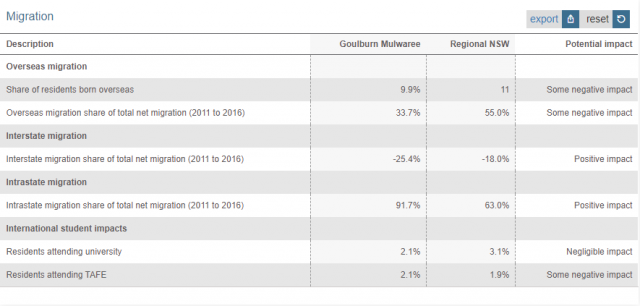
Recent data released by the ABS suggests that, due to border closures, interstate migration declined. However, intrastate migration has grown which suggests a positive impact for rural areas like Goulburn. The data is showing large numbers of capital city residents migrating out since the start COVID-19 pandemic. Even Melbourne’s ‘ring of steel’ hasn’t stopped the flow, with the city recording a net loss of over 8,000 residents in the June quarter. The two graphs below for Victoria and NSW, illustrate that the majority of Melbexiters and Sydeparters who packed their bags and office equipment stayed within their respective state.
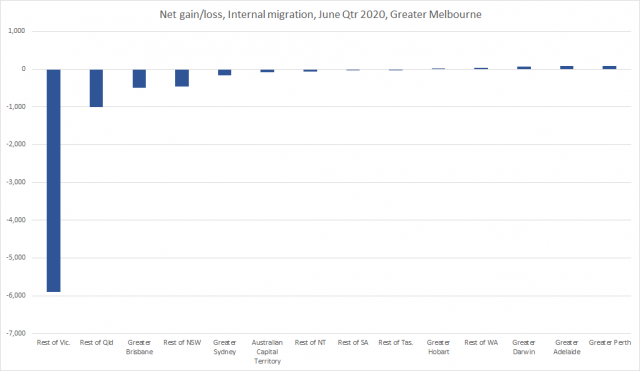

It remains to be seen if this is only a temporary move (some potentially to second homes) or a more permanent relocation to work and live on the land. The size of the lasting impact will be dependent on the take up of remote work and a rural area’s proximity to the major metropolitan areas and/or regional cities.
Economic upside for some communities
Unlike other sectors of the economy who have greatly suffered due the coronavirus pandemic, primary industries and agriculture (the lifeblood of many rural areas) has been largely unaffected. Some rural areas are forecast to experience positive economic change and local employment growth. Goulburn is one such LGA with increases in Gross Regional Product (+.6%) and employed residents (2.3%) expected in the short term. Goulburn benefits from its proximity to employment markets in both Canberra and Sydney, and its availability of affordable housing. In addition to location and local amenity, if work from home becomes permanently accepted by employers and employees alike then the attractiveness of rural areas as a place to live is likely to increase further.
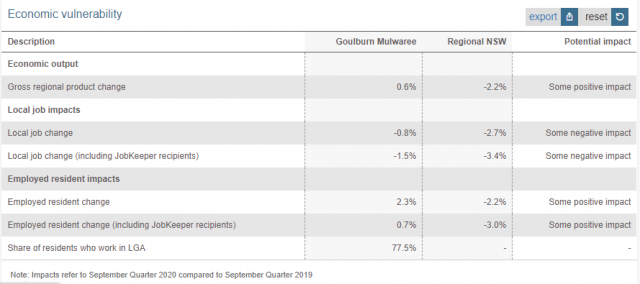
But challenges in others
However, many rural businesses heavily rely on temporary visa holders to work on the annual harvest and fill roles in other primary industries and due to the closed international border they are now in short supply.
These seasonal workers, whether backpackers or young migrant families, have become an integral feature of some parts of rural Australia. To make up for this shortfall the Federal government has introduced relocation grants to encourage both foreign workers and Australian residents to the regions. If this is not effective there may be a shortfall in food production and affected towns may suffer a loss of residents. If history is any guide, these types of programs have little long term success in boosting rural and regional populations, with participants quickly moving back to capital cities when allowed.
A silver lining?
The majority of rural areas across Australia have over many years experienced declining populations and aging populations as young adults move to larger regional or capital cities in search of education and employment opportunities, with backpackers and seasonal workers filling the void.
However, even before COVID-19, the ‘super commute’ was becoming popular as more people sought larger, more affordable living in the regions. Until now, this has been mainly contained to areas in close proximity to major cities. The impact of the COVID-19 pandemic may have spread this attraction further afar to rural areas, as the ease of access to the office becomes less relevant. Stories like these of young adults moving back to the family farm coupled with the recent intrastate migration numbers and increase in regional property prices suggest that some rural areas are in fact seeing a mini boom.
What’s the impact of COVID-19 on other parts of Australia?
The next place typology we will be looking at is Coastal areas. Subscribe to our blog for updates as we roll out this analysis, or to our product updates to be notified when new data and features are added to our online tools.

